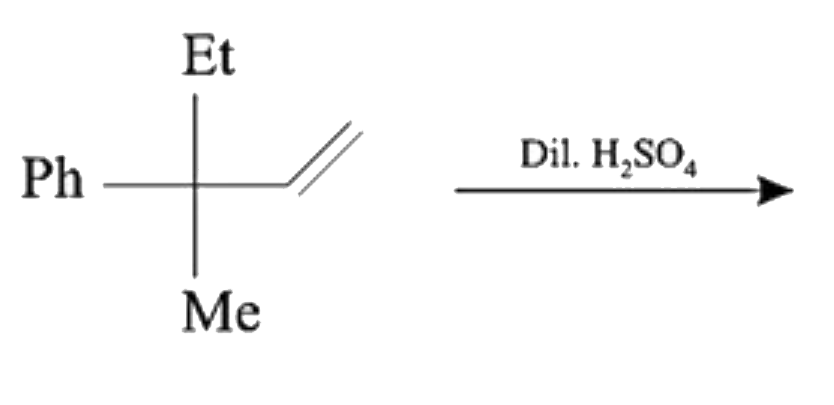The major product of reaction between n-butane and bromine at 130∘C is
CH3CH2CH2CH2Br
CH3CH2CH∣CH3Br
CH3−C∣CH3HCH2Br
CH3−C∣CH3−Br2
The correct Answer is:B
To determine the major product of the reaction between n-butane and bromine at 130°C, we can follow these steps:
Step 1: Identify the Reactants
We start with n-butane, which has the molecular formula C4H10 and can be represented as:
CH3CH2CH2CH3
Step 2: Understand the Reaction Conditions
The reaction is taking place in the presence of bromine (Br2) and at a high temperature of 130°C. This suggests that a free radical halogenation reaction will occur.
Step 3: Mechanism of the Reaction
In free radical halogenation, the reaction proceeds through three main steps: initiation, propagation, and termination. At high temperatures, bromine can homolytically cleave to form bromine radicals.
Step 4: Formation of Free Radicals
When n-butane reacts with bromine, free radicals are formed. The hydrogen atoms in n-butane can be replaced by bromine atoms, leading to the formation of different alkyl bromides.
Step 5: Stability of Free Radicals
The stability of the free radicals formed during the reaction is crucial in determining the major product. The possible free radicals that can form from n-butane are:
- Primary free radical (1°) from the terminal carbon
- Secondary free radical (2°) from the second carbon
Since secondary free radicals are more stable than primary free radicals, the reaction will preferentially lead to the formation of the more stable secondary radical.
Step 6: Identify the Major Product
The major product will be formed when bromine replaces a hydrogen atom from the carbon that forms the more stable secondary radical. The major product of this reaction will be:
CH3CH2CHBrCH3
This can also be represented as 2-bromobutane.
Conclusion
Thus, the major product of the reaction between n-butane and bromine at 130°C is 2-bromobutane.
Final Answer
The major product is CH3CH2CHBrCH3 (2-bromobutane).
---
We start with n-butane, which has the molecular formula C4H10 and can be represented as:
CH3CH2CH2CH3
The reaction is taking place in the presence of bromine (Br2) and at a high temperature of 130°C. This suggests that a free radical halogenation reaction will occur.
In free radical halogenation, the reaction proceeds through three main steps: initiation, propagation, and termination. At high temperatures, bromine can homolytically cleave to form bromine radicals.
When n-butane reacts with bromine, free radicals are formed. The hydrogen atoms in n-butane can be replaced by bromine atoms, leading to the formation of different alkyl bromides.
The stability of the free radicals formed during the reaction is crucial in determining the major product. The possible free radicals that can form from n-butane are:
- Primary free radical (1°) from the terminal carbon
- Secondary free radical (2°) from the second carbon
The major product will be formed when bromine replaces a hydrogen atom from the carbon that forms the more stable secondary radical. The major product of this reaction will be:
CH3CH2CHBrCH3
This can also be represented as 2-bromobutane.
Thus, the major product of the reaction between n-butane and bromine at 130°C is 2-bromobutane.
The major product is CH3CH2CHBrCH3 (2-bromobutane).
Topper's Solved these Questions
- ALKENE, ALKANE & ALKYNE Book:ALLENChapter:ALKENE, ALKANE & ALKYNE Exercise:EXERCISE-4[A]
Explore 50 Videos
- ALKENE, ALKANE & ALKYNE Book:ALLENChapter:ALKENE, ALKANE & ALKYNE Exercise:EXERCISE-4[B]
Explore 47 Videos
- ALKENE, ALKANE & ALKYNE Book:ALLENChapter:ALKENE, ALKANE & ALKYNE Exercise:EXERCISE-5(A)
Explore 28 Videos
- AIIMS 2019Book:ALLENChapter:AIIMS 2019Exercise:CHEMISTRY
Explore 40 Videos
- ALKYL AND ARYL HALIDEBook:ALLENChapter:ALKYL AND ARYL HALIDEExercise:EXERCISE-05 (B)
Explore 35 Videos
Similar Questions
Knowledge Check
The major product formed in the reaction
 A
A B
B C
C D
D
The major product formed in the reaction :
 A
A B
B C
C D
D
The major product formed in the reaction :
 A
A B
B C
C D
D






